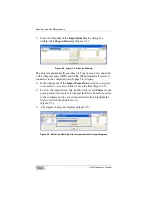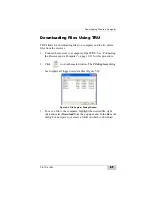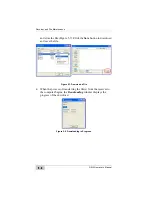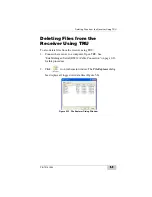
Static Surveying for Base Stations
P/N 7010-1004
4-11
Static Surveying for Base
Stations
Static surveying is the classic survey method, well suited for all kinds
of baselines (short, medium, long). At least two receiver antennas,
plumbed over survey marks, simultaneously collect raw data at each
end of a baseline during a certain period of time. These two receivers
track four or more common satellites, have a common data logging
rate (5–30 seconds), and the same elevation mask angles. The length
of the observation sessions can vary from a few minutes to several
hours. The optimal observation session length depends on the
surveyor’s experience as well as the following factors:
• The length of the baseline measured
• The number of satellites in view
• The satellite geometry (DOP)
• The antenna’s location
• The ionospheric activity level
• The types of receivers used
• The accuracy requirements
• The necessity of resolving carrier phase ambiguities
Generally, single-frequency receivers are used for baselines whose
lengths do not exceed 15 kilometers (9.32 miles). For baselines of 15
kilometers or greater, use dual-frequency receivers.
Dual-frequency receivers have two major benefits. First, dual-
frequency receivers can estimate and remove almost all ionospheric
effect from the code and carrier phase measurements, providing much
greater accuracy than single-frequency receivers over long baselines
or during ionospheric storms. Secondly, dual-frequency receivers
need less observation time to reach the required accuracy.
After the survey completes, data the receivers collect can be
downloaded onto a computer and processed using post-processing
software (for example, Topcon Tools).
Summary of Contents for GR-5
Page 1: ... PERATORlS ANUAL ...
Page 2: ......
Page 4: ...ECO 4074 ...
Page 9: ...Table of Contents P N 7010 1004 v WEEE Directive C 2 Appendix D Warranty Terms D 1 Index ...
Page 10: ...Table of Contents GR 5 Operator s Manual Notes vi ...
Page 16: ...Preface GR 5 Operator s Manual Notes xii ...
Page 18: ...Introduction GR 5 Operator s Manual 1 2 Figure 1 1 GR 5 Receiver ...
Page 44: ...Introduction GR 5 Operator s Manual Notes 1 28 ...
Page 99: ...Configuring the Receiver Using TRU P N 7010 1004 3 27 Figure 3 24 Add New Message ...
Page 121: ...MINTER Configuration P N 7010 1004 3 49 Figure 3 42 MINTER Tab ...
Page 122: ...GR 5 Configuration GR 5 Operator s Manual 3 50 ...
Page 170: ...Troubleshooting GR 5 Operator s Manual Notes 6 12 ...
Page 188: ...GR 5 Operator s Manual Notes A 18 ...
Page 192: ...GR 5 Operator s Manual Notes B 4 ...
Page 196: ...GR 5 Operator s Manual Notes D 2 ...
Page 201: ......















































